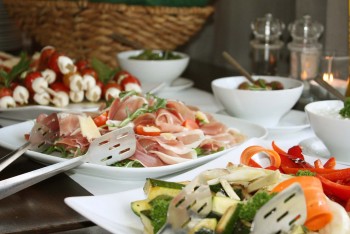Funeral Dinner Menu Planning
Although you are not required to feed all the funeral guests as soon as the service is over, partaking of a funeral dinner (or luncheon) is a common part of the mourning ritual. Some families choose to have this event catered, some hold it in a favorite restaurant or bar, some ask for guests to bring dishes to eat potluck style, and still others do the cooking themselves.
While there is no right or wrong way to hold a funeral dinner, it is common to serve comfort foods and favorite dishes of the deceased. If you are planning a funeral dinner menu, here are a few staples you won’t want to miss.
- Casseroles: Casseroles are popular among funeral crowds for several reasons. For one, they can be prepared ahead of time, making serving the meal as easy as heating the dish and setting it out. For another, they tend to be heavy on things like cheese and carbohydrates—comfort foods that appeal to a broad range of people. (If you will be asking people to supply dishes for a potluck, these have the added advantage of freezing well or being eaten as leftovers.)
- Sandwich Platters: Sandwich platters typically include bread, meat, cheese, and other fixings for sandwiches. Easy to make (or purchase), they offer guests a chance to create their own meals, and tend to work best when the funeral dinner is meant to be more relaxed and casual.
- Buffet-Style Meats: If you will be serving funeral guests a hot meal, buffet-style meats (ham, turkey, or roast that is carved) work best. You can also opt for meatballs, fried chicken, or pulled pork, which can be portioned to suit each individual guest’s appetite. Barbeques tend to work best when the funeral takes place in good weather or the after-service is held outdoors.
- Salads: If you want to serve salad at a funeral luncheon or dinner, avoid ones that will spoil easily or that have dressing directly on the greens (as they tend to wilt quicker). Pasta salad, bean salad, gelatin salad, and build-your-own salads work best in this type of situation—especially if the leftovers can be stored and served later.
- Finger Foods: If you are not feeling up to the task of heavy cleanup after the funeral dinner, stick to finger foods that minimize the need for serving dishes, cutlery, and plates. Vegetable trays, chips and dip, hummus and pita bread, kabobs, miniature sandwiches, and other items you can eat with your hands will minimize the amount of work you have to do once everybody leaves.
- Desserts: Nothing says comfort food quite like dessert. Funerals are not the right occasion for an elaborate cake or festive cookies, but it is always a good idea to add something sweet to the menu. Cookies and cupcakes, dishes of candy, dessert bars, and other treats tend to work well in funeral settings. These go over well when served with coffee.
As with most tasks related to funeral planning, it is best not to stress too much about the funeral dinner. Although it is nice to want to provide a meal for family and friends, it is more about being together than providing five-star dishes and table service. Stick to simple, comforting foods and put the focus on celebrating the life of the deceased. The funeral dinner will be all the better for it.
Please share your thoughts on this article
Related articles
Reasons to Delay a Funeral
Most funeral experts recommend that a funeral should take place as soon after death as possible—usually within a week or so. Not only is this necessary when you’re talking about the disposal of human remains (when burial is the choice), but i... more »
Writing a Personal Memoir
One of the things many people want to do before they die is to write their life story or personal memoir. After all, once you are gone, all that will remain are the memories other people carry of you—your life as seen through someone else’s p... more »
Notifying Family Members of a Recent Passing
One of the most often overlooked steps in funeral planning is communicating the passing of a loved one to others. While an obituary will do a good job of notifying the general community of the death, including where they can send flowers or attend a ... more »



